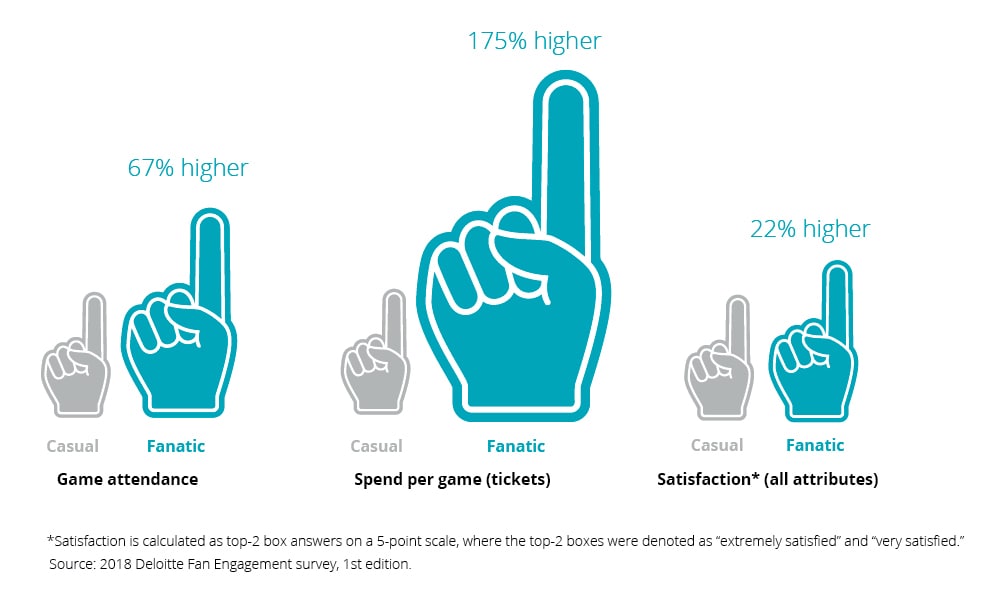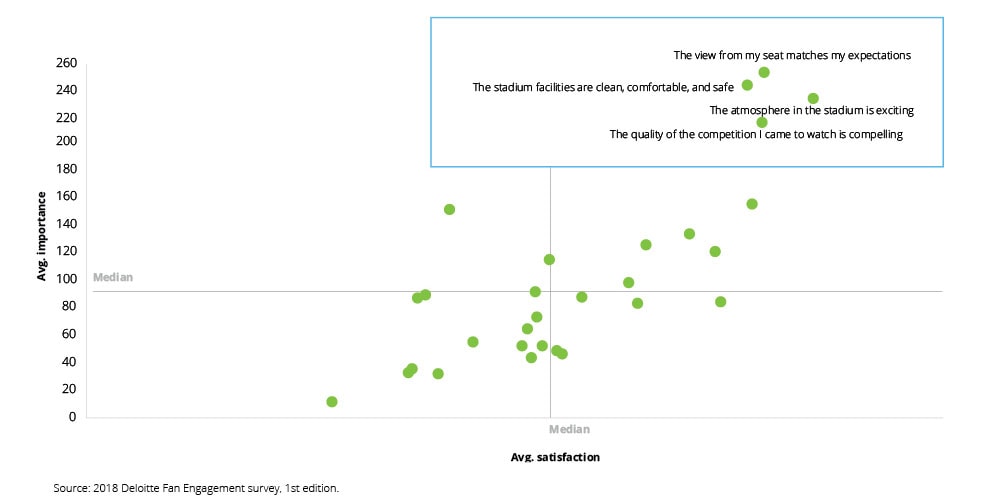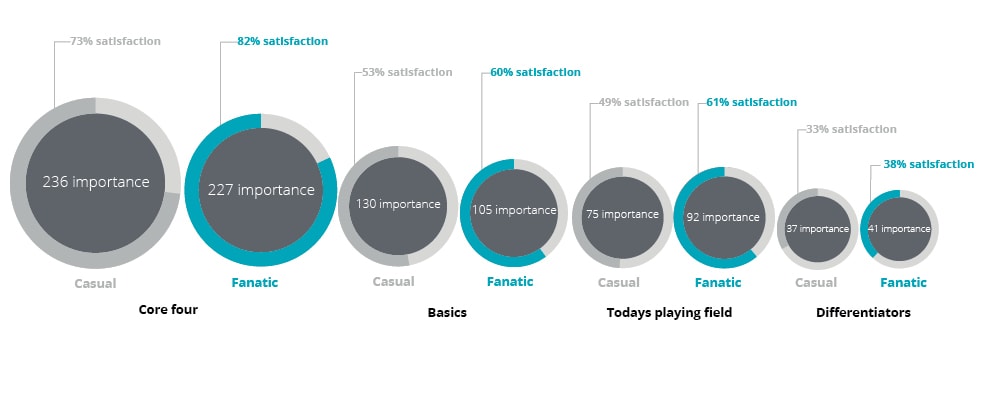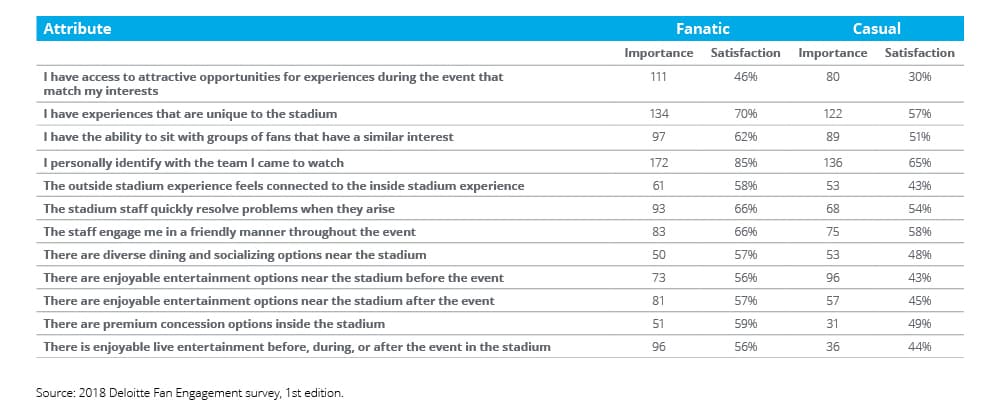The stadium experience has been saved

Perspectives
The stadium experience
Keeping sports fans engaged—and loyal
Nothing can beat a great stadium experience—or can it? Fans at home these days enjoy better camera angles, augmented and virtual reality, and multiplatform, multimedia experiences, ratcheting up pressure on stadiums to deliver an experience the living room can’t match. Luckily, fans are clear about what they want from their stadium experience, and teams that deliver reap the ultimate reward: more loyal, engaged fans.
Explore content
- A great stadium experience bolsters fan loyalty
- Survey of over 15,000 sports fans across the country
- Get the basics right
- Case study: Falcon’s Concessions
- Today’s playing field
- Innovate on differentiators
- Case study: 49ers mobile app
- Conclusion
- Key differences in relative importance and satisfaction
- Endnotes
- Get in touch
- Join the conversation
Sports have long been an integral part of our culture, from the earliest form of football in ancient China, Cùjū, to the spectacle of the Colosseum in ancient Rome. Sports and entertainment leaders around the globe have long understood the importance of atmosphere and excitement in keeping fans happy and engaged.
Fan engagement is central to driving these fans to the stadiums, convincing them to spend over $50 billion annually on their favorite teams and leagues, and developing bonds strong enough to push a fan from their first ballgame to a life-long attachment. This engagement is a cohesive whole that encapsulates a fan’s experience watching games on TV or through streaming media, and their experience interacting with teams year-round.
This article is part of a series, driven by a 15,000+ person survey that Deloitte conducted addressing each of the three individual aspects of fan engagement starting with the stadium experience, before addressing streaming and broadcast media and the year-round fan experience.
A great stadium experience bolsters fan loyalty
In 1989, Field of Dreams introduced us to Ray Kinsella and the belief that “if you build it, (they) will come.” Ray built his stadium, the team came, and the fans followed. Ray’s stadium was simple—a cornfield with minimal seating along the lines, but it had a baseball game, a compelling team, and no obstructed views—and that’s all that mattered.
While stadiums have grown into hundred-million-plus dollar developments, with multistory videoboards, luxury seats and suites, and a variety of entertainment from mascot antics to fireworks, the basic tenets of the fan experience—a good game and clean views—have persisted since the time of Kinsella’s stadium.
However, today’s stadiums face increasing competition from improved home viewing options, powered by better camera angles, the growth of augmented reality/virtual reality (AR/VR), and multi-platform, multimedia experiences. At the same time, the monetary cost and time commitment of stadium attendance remains high. As a result, while revenues for teams have steadily increased, stadium attendance has stagnated or decreased slightly across many of the leagues studied.
In today’s world, building it is not enough to make them come. In order to win fans today and to keep them coming back into the future, stadiums not only need to get the basics right, beginning with the core four expectations of fans,
Our survey showed that success across these elements ultimately can lead to more satisfied fans, who are more emotionally connected to the team. These emotional connections drive fan loyalty—pushing fans up the tiers of fandom assessed in our study, from casual fans who occasionally engage with teams, to “love it” fans and, ultimately, to fanatics. This loyalty, in turn, drives business results—increased ticket sales, and increases in in-stadium purchases.
To analyze fan engagement, we conducted a survey of over 15,000 sports fans across the country on their experience across seven major leagues: MLB, MLS, NASCAR, NBA, NFL, NHL, and the WNBA, and three types of fans: casual fans, fans that love the league, and fanatics.
Across this sample of fans, which was selected to be broadly representative of the US population across age, gender, ethnicity, and income, our survey had three sections that aimed to answer a series of key questions that address the three key forums of the fan experience:
- What are fan expectations of the stadium experience, including how teams and stadiums address the fan’s basic needs and engage the fan?
- What are fans’ current levels of expectation and perceptions for consuming the game, stats, highlights, and team news during a live game across channels (broadcast, over-the-top/streaming media, and digital)?
- What are the key drivers of the fan experience when interacting with and staying connected with the team outside of the game, throughout the year?
In addition to these three core questions, we included a fourth section of the survey, addressing the desired fan experience in the rapidly emerging world of eSports. This section included channels for consuming the games, interacting with players and teams, and connecting with fellow fans.
Get the basics right
Fans—whether they are young or old, fanatics or casual fans, football fans or fútbol fans—have a “core four” set of expectations when they arrive at the stadium, complemented by a set of other basic needs. Success across these attributes is a necessary prerequisite for establishing a base of engaged and satisfied fans that repeatedly attend games in-stadium instead of watching games from the comfort of their own homes.
The core four
Fan’s core four expectations are:
- They expect the stadium to be safe, comfortable, and clean.
- They want the view from their seats to match their expectations.
- They desire a high-quality game.
- They expect an exciting atmosphere within the stadium.
While these four attributes are unsurprising leaders in fan importance, what is striking is the extent to which they outpace other elements. On average, our survey showed they are more than 50 percent important than the next closest aspect of the stadium experience. The good news for teams is that fans are relatively satisfied with these core four experience elements—they are four of the only five attributes in the study that achieved more than 75 percent satisfaction at the aggregate level (figure 1).
While the core four have the highest satisfaction level we found, teams and leagues still have significant opportunity to increase satisfaction on these attributes through continued development and focus.
Figure 1. The relative importance/satisfaction with the core four
While the core four attributes remain the most important attributes across all sports, fan types, and age groups, casual fans place relatively higher importance on these attributes. For casual fans, our survey shows that the core four are 75 percent more important than the next closest attribute. And yet satisfaction for this group is lower across the board, showing that teams have work to do to push casual fans to the higher attendance and spend levels seen in the fanatic group.
Notably, the gap shrinks to a mere 31 percent for fanatics. This suggests that some of the smaller, more nuanced elements of the stadium experience stand out to the fanatic more than the typical fan (figure 2).
Figure 2. Fanatics vs. casual comparison
Enlarge image

As fans are considering their desired experience, each of these elements carries significant weight, though both importance and satisfaction among fans
Figure 3. Satisfaction and importance across the core four and rest of the basics
Of particular note among the remaining basics are concessions, a favorite for fan complaints, and the source of some of the lowest satisfaction scores in the data set. Sports have historically seen high concession prices at stadiums, though there are several examples that challenge this norm, both in and out of
For example, Amazon Prime challenged the concept of high unit prices and shipping
Despite their high relative importance to fans, the basics are just that—the table stakes that set the foundation for the stadium experience. As the Falcons example shows, there are still ways to improve the basics and increase both fan revenue and satisfaction simultaneously. However, in and of themselves the basics are just that—basics. They are necessary, though not sufficient on their own to create a cohesive fan experience that will consistently win out over the out-of-stadium opportunities, and draw fans to purchase tickets and attend games in person.
Case study
Falcon’s concessions
Responding to feedback from fans, Falcon’s owner Arthur Blank decided to drastically reduce concession prices in their stadium in 2016. After cutting prices by 50 percent, the Falcons saw an increase of 16 percent in overall fan spend in the stadium.4
Additionally, the number of fans entering the stadium two or more hours before kickoff increased by an overage of 6,000 per game, demonstrating the power of addressing key areas of fan dissatisfaction within the stadium. Going forward, the Falcons are doubling down on these price cuts—cutting $1 from a number of “premium” items for the 2018–2019 season, representing a further 12 percent decrease in concession prices.5
Today’s playing field
Once stadiums have enticed a fan to come to a game, it is important to go beyond the basics, delivering a fan experience that will keep today’s fans returning to the stadium, as well as spending their time and money in other associated channels. The next level of experiential elements—the playing field that stadiums compete on today—includes:
- Personal identification with the team
- The ability to have experiences that are unique to the stadium
- Experiences that match their personal interests
- Live entertainment options before, during, and after the game, and
- The opportunity to sit with fans who share their interests
Out of these elements, our research shows that
The implication here is that stadiums must consider the future generation in today’s experience, adjusting to a changing, younger fan base, buoyed by millennials who have a 7 percent higher likelihood than boomers of being fanatics, that places relative importance on a different set of experiential attributes—the ability to have unique experiences within the stadium; having experiences that match their personal interests; live entertainment options before, during, and after the game; and the opportunity to sit with other fans who share their interests—while maintaining loyalty amongst the older generation.
On aggregate, the attributes that
Our research clearly finds that current efforts to deliver on these experiential elements are not sufficient to satisfy fans. On average, satisfaction across these elements is approximately 55 percent.
However, increasing the satisfaction score across these elements may not be as simple as bringing in bigger entertainment names, doing more interesting giveaways, or setting up specialized fanatic sections in the stadium. Rather, what stands out about these attributes is the focus on personalization, and truly knowing and understanding the individual fans in their stadiums as well as their specific interests (figure 4).
Figure 4. Satisfaction and importance across playing field of today
Given the relative importance and dissatisfaction with these experiential attributes, particularly for younger, next-gen fans, teams should prioritize building a robust understanding of their fan’s behaviors, creating a single view of the customer that can be leveraged to deliver personalized entertainment options as well as mechanisms to foster in-stadium communities of fans. Furthermore, teams must look to communicate these options in a cohesive and coherent way that speaks to each fan as an individual, emphasizing the true personalization of the experience and offer that is being presented to them as part of their time in the stadium.
Innovate on differentiators
With the high importance for basic, personalized, unique entertainment, and a desire to identify with the team the fan is watching, there are several attributes such as mobile use and apps, Wi-Fi access, and personalized attention from staff members that are conspicuous for their absence from the lists of highly important attributes covered thus far.
Notably, attributes related to mobile use in
Figure 5. Importance and satisfaction across differentiators
Instead of throwing out these attributes as unimportant to the fan experience, and therefore not worthy of investment or focus, this combination of low importance ratings and low satisfaction suggests that the mobile experience has not yet been properly developed. It provides an area where teams innovate and differentiate their experience, creating the basis for engaging fans and encouraging them to continue coming to the stadium for years to come.
Teams and leagues have the opportunity to innovate for a fan base that may not yet know exactly what they want to receive, and helping occupy the significant downtime between plays, during timeouts, and between periods that exist in stadiums across sports can add value to time that might seem unused otherwise.
Additionally, there is significant room for innovation to elevate the connected, mobile experience to link fans, helping them with some of the “basics,” as well as introducing new, unique experiences captured in today’s differentiating attributes that they care most about. These innovations could include areas such as connecting fans to others that share their passions, tapping into the important attributes covered as the playing field of today by providing access to the unique activities and entertainment options that match their personal
The key for each of these innovation areas will remain to integrate seamlessly with the rest of the stadium experience without encroaching on the excitement of the stadium atmosphere.
To incorporate these differentiators, teams have developed seating sections for specific groups of fans, AR/VR experiences within the stadium, improved wireless access, customized mobile content, and competitions for fans in the stadium.
While all of these
Moving forward, these innovations will be critical to the continued success and viability of the in-stadium experience as out-of-stadium competition grows stronger, and as the younger fans that are growing into increasingly large percentages of sports fans over the coming years identify less and less with the individual team that they come to the stadium to watch.
Case study
49ers mobile app
The San Francisco 49ers recently rolled out a new mobile app specifically intended to address several of the key pain points for fans within the stadium. The app helps fans before they arrive at the stadium, integrating parking access, before serving as the home of the mobile ticket and providing directions to seats and other key areas in the stadium.
Beyond saving time getting to seats, the app addresses the common concern regarding waiting time for concessions, providing an option to order through the app for express pickup, in addition to the in-seat delivery option—something that 60 percent of fans said would significantly improve their likelihood of downloading the team’s mobile app. The app has led to $2M in increased revenue for the team along with adoption 6x the industry standard, providing the team improved data to go alongside revenue improvements.6
Cultivate a deep understanding of individual fan bases
As teams look to drive increases in repeat attendees and season ticket holders, while broadening their base of fanatics—the groups responsible for the highest levels of spend on tickets and in the stadium, increasing fan satisfaction is paramount through the creation of a cohesive in-stadium experience. As our survey has shown fans who are more satisfied attend more games relative to their level of fandom.
For the WNBA—the sport with the highest level of satisfaction across the board—fans attend approximately 40 percent more games per year at each level of fandom compared to the average across the other leagues studied. Not only did those fans attend more games, they spent more per ticket, showing strong overall correlation between satisfaction and total season spend on tickets.
To allow teams to achieve this benefit both in terms of in-stadium support from fans and for teams’ bottom lines, teams must first ensure that they have addressed the basics. They need to put a compelling, high-quality team on the floor, in a clean, safe, and comfortable stadium with seats that have quality views matching fans’ expectations, and that fosters an exciting, energetic environment.
Once they have addressed the core four attributes that dominate fans’ relative importance, teams can focus on addressing the rest of the basic needs, and building a team persona through their in-stadium, broadcast, and year-round engagement strategy that fans feel that they can identify with.
By addressing these basic attributes, teams will cover the fundamentals of in-stadium fan engagement, encouraging fans to come to the stadium. As broadcast and over-the-top streaming channels continue to improve, though, teams will need to go beyond these foundational elements to elevate, personalize, and connect the disparate elements of the in-stadium experience competing across the attributes that make up the stadium playing field of today, as well as differentiating with new experiences such as mobile to continue to draw fans in the future.
To truly develop these offerings, teams will need to cultivate a deep understanding of their own individual fan bases to personalize sets of offerings to individual fans—continuing to lift the experience of the stadium above that of the home.

Across sports we saw several other key differences in relative importance and satisfaction:
- WNBA fans are 20 percent more satisfied on aggregate compared to the rest of the sports surveyed.
- NASCAR fans put nearly 20 percent greater relative importance on being “delighted” in the stadium before, during, and after the race through tailored and unique experiences, and other entertainment options.
- NFL and NHL fans put significantly less importance on pre-and post-game activities—in spite of the popularity of tailgating before NFL games.
- Fans of the NBA, NFL, and MLB put the lowest relative importance on elements related to mobile usage during the game, while NASCAR fans ranked these the highest of any sport.
- Baseball fans had the most stratified importance rankings of any sport, with their most important attribute—the view from their seat matching expectations—26 times as important as their least important—stadium staff knowing their preferences.
- WNBA, MLS, and NHL fans are the most satisfied with the basics in the stadium, with each achieving satisfaction ratings of over 62 percent.
- While all sports scored over 80 percent in satisfaction for an exciting stadium atmosphere, NHL and NFL led the way at 87 percent.
- While fanatics average nearly 12 percent higher satisfaction compared to the full fan-base, NBA and WNBA fanatics have the largest difference, at 16 percent and 17 percent higher respectively.
- NFL, MLB, and NHL fanatics are all particularly satisfied with how they are able to identify with the team they are watching, with satisfaction scores for all three groups over 87 percent.
- MLS and WNBA fans are nearly 10 percent more satisfied than fans of other sports with their ability to sit with fans of similar interest levels.
Endnotes
1 CNBC. “Americans spend $56 billion on sporting events,” September 12, 2017.
2 Kevin Costner, Amy Madigan, James Earl Jones, Dwier Brown, Frank Whaley, Ray Liotta, Burt Lancaster, Lawrence Gordon, Charles Gordon, Phil A. Robinson, and W P. Kinsella. Field of Dreams. Universal City, CA: Universal, 1999.
3 ESPN. “Hot Dog! Falcons drop concession prices, make more money,” January 25, 2018.
4 Atlanta Falcons. “Mercedes-Benz Stadium to cut concession stand prices on popular items by 12 percent,” August 24, 2018.
5 VenueNext. “The San Francisco 49ers and the Brand New Levi’s Stadium,” accessed December 2018.
6 Business Insider. “We tried the San Francisco 49ers app that lets you deliver food to your seat—and it might be the future of live sporting events,” September 27, 2015.
Read more on Redesigning stadiums for a better fan experience.
Engaging fans in person and at home

With the proliferation of 24/7 sports TV channels, dedicated radio stations, and independent podcasts, there is no off-season. And there have never been as many opportunities for sports organizations to stay connected with their fans. Learn more about sports marketing strategies to boost year-round engagement.
Learn more
In a world where consumers are no longer tied to broadcast and cable schedules to catch their favorite shows, live sports are the exception. Sports is one of the few remaining content types/genres that fans will go out of their way to watch live. This passion equates to a big opportunity for sports teams, advertisers, and over-the-top streaming and broadcast media companies. The future of sports broadcasting includes new ways to keep fans engaged and capture their attention with compelling, authentic experiences.
Learn moreAuthors
Chad Deweese |
Sam Ebb |
Explore content
- A great stadium experience bolsters fan loyalty
- Survey of over 15,000 sports fans across the country
- Get the basics right
- Case study: Falcon’s Concessions
- Today’s playing field
- Innovate on differentiators
- Case study: 49ers mobile app
- Conclusion
- Key differences in relative importance and satisfaction
- Endnotes
- Get in touch
- Join the conversation
Recommendations
How legalization impacts sports betting economics
A closer look at factors shaping the future of online sports betting







